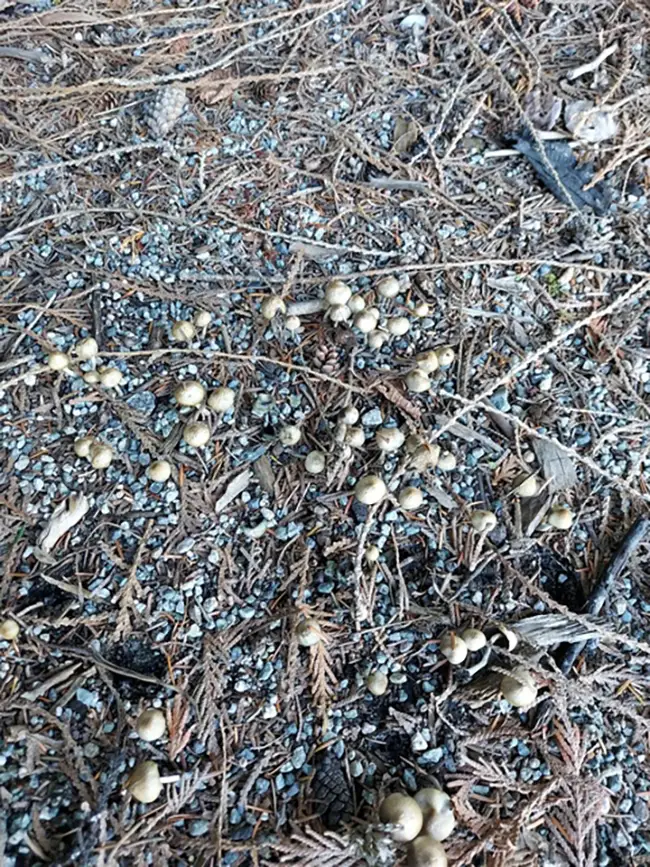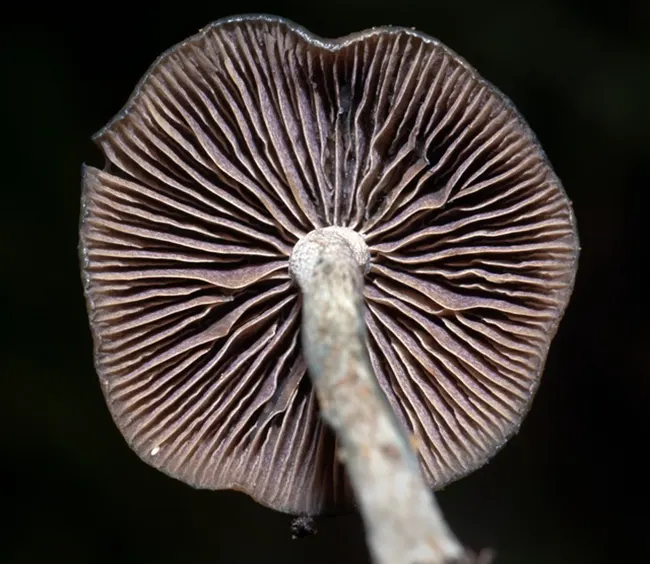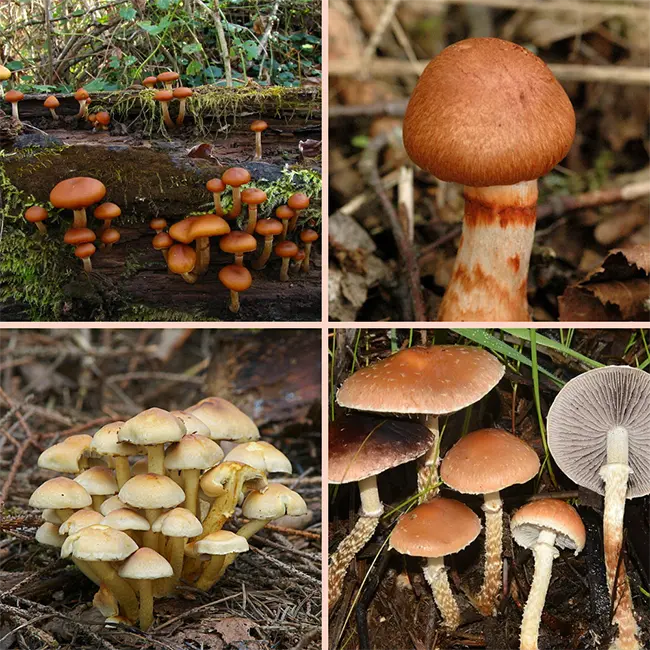By the latest—and highest—estimates, fungi predate humans by a potential 809 million years. They are far older than us, yet there’s still a lot that we don’t know. Mycologists have described only a tiny portion of fungi that exist worldwide—and it’s unclear how much Indigenous knowledge we’ve lost due to the impact of colonization and Western imperialism. It took until 1945—in the humble city of Eugene, Oregon—for scientists to first collect the mushroom that would become Psilocybe baeocystis. It took even longer for the fungus to make it into the guidebooks. The mushroom wasn’t formally described and named until much later: German mycologist Rolf Singer and American mycologist Alexander H. Smith recorded it in the scientific literature in 1958.
The species name comes from the Greek words for “little” (baeo) and “bladder” (kystis). But it’s not exactly clear why the mushroom deserved the name—the original article naming the species doesn’t explain. Still, it may originate from a number of features of this mushroom: the shape of its inwardly-rolled cap or the appearance of microscopic cells called cheilocystidia that mycologists use to identify different mushroom species.
But, less than four years later, there was a problem. There were several mushroom poisonings in the region, including the death of one child in 1960. P. baeocystis was the main suspect. Researchers began testing the chemical constituents of the fungi. By 1962, four years after the mushroom received its new name, researchers found psilocybin. Then, between 1967 and 1968, chemists Albert Leung and Ara Paul discovered the related alkaloids baeocystin and norbaeocystin in P. baeocystis. The scientists named the compounds after the mushroom itself. The poisonings might have put this mushroom on the deadly list if it was not for Paul Stamets.

In his 1996 book, “Psilocybin Mushrooms of the World,” Stamets claims to have had a conversation with Alexander H. Smith, who originally discovered P. baeocystis. Stamets claimed to have shown Smith photographs of the supposed P. baeocystis associated with the deadly 1960s poisoning, who immediately dismissed them as false identification. Stamets also claimed Smith told him that other mushrooms were present in the yard where the fatal poisoning happened, but no one identified the other mushrooms. So, it’s possible that these other mysterious mushrooms caused the unfortunate death. Dr. Andrew Weil’s writing in 1977 corroborates this story. Weil stated that P. baeocystis was Oregon’s second most prized species for its psychoactive effects. If it were truly poisonous—as some claimed at the time—its popularity amongst mycological psychonauts would be unlikely.
In the intervening years, other famous entheogenic researchers and mycologists frequently mentioned P. baeocystis in their writings, including Gaston Guzman, Jochen Gartz, and Jonathan Ott. Jonathan Ott and Jeremy Bigwood reported that Psilocybe baeocystis went by the common name “knobbly tops” in their 1978 book Teonanacatl: Hallucinogenic Mushrooms of North America. Stamets’ 1996 book also mentioned this common name. Today, you rarely hear common names for P. baeocystis since the popularity of the mushroom itself has waned, possibly driven by how infrequently it’s found and recorded by foragers. However, given its important contribution to the discovery of other alkaloids in Psilocybe species, the fungi are well worth learning about!
Psilocybe baeocystis Potency
Like many magic mushrooms, the potency of P. baeocystis can vary significantly between both mushroom patches and mushroom batches. Our few measurements of alkaloid concentration for Psilocybe baeocystis give a psilocybin range of 0.15 to 0.85 percent, a psilocin range of 0 to 0.59 percent, and a baeocystin range of 0 to 0.1 percent. Despite norbaeocystin being discovered in P. baeocystis back in the 1960s, due to the measurement methods used, the researchers have yet actually to measure its concentration.
How to Grow Shrooms Bundle
Take Both of Our Courses and Save $90!
Where Can I Find Psilocybe baeocystis?
P. baeocystis is a rare temperate-to-hemiboreal zone mushroom and has only been observed in a few locations in the USA. The Northern Pacific Northwest is your best location to stand a chance of finding this species.
READ: Where Do Magic Mushrooms Grow?

Psilocybe baeocystis Habitat/range/season
Unlike other species—like Psilocybe cyanescens and Psilocybe allenii, which favor a similar habitat—P. baeocystis may have a much more constricted geographical range. Though the original mushrooms that gained the name Psilocybe baeocystis were discovered in Oregon, this species has since been recorded in Washington and British Columbia, with possible sightings in further away states like North Carolina and New Hampshire. Given its rarity and somewhat patchy distribution, this mushroom might be waiting to be discovered in other regions of the US (or even the world!) with similar habitat, so keep a keen eye out on your next foray!
Psilocybe baeocystis Growing Conditions
Like other wood-loving psilocybe species, P. baeocystis appears synanthropic—a fancy word for “growing in human-created habitat.” In this case, the fungus enjoys a mulched bed of wood chips, such as in cultivated flower beds or under bushes. It also sometimes grows through moss and grass, but usually, in these cases, the mycelium feeds on wood buried beneath the surface. Though most wood-loving Psilocybe species seem to prefer hardwood chips (from trees that lose their leaves over winter), researchers documented P. baeocystis growing on chips from conifers like Douglas fir (Pseudotsuga menziesii). P. baeocystis is rarely found growing outside of a human-cultivated habitat.
Within its limited range of the Northern Pacific Northwest, Psilocybe baeocystis grows from late summer to early winter. They usually grow as single mushrooms scattered over a wider area or in loose groups. Occasionally, P. baeocystis grows in dense clumps, a growth pattern mycologists call “caespitose.”
READ: How to Identify Magic Mushrooms

Psilocybe baeocystis Identification
Psilocybe baeocystis grows to a maximum height of 2 ¾ inches (7 cm), with a maximum cap diameter of slightly over 2 inches (5.5 cm). The cap’s edges characteristically turn inwards in younger specimens, giving the mushrooms a knobbly-round appearance. As the cap matures, it takes on a more rounded cone shape, with the cap margin unfurling and hanging down with a distinct rippled appearance. In very old specimens, the cap can occasionally open out and flatten completely, but this is rarely seen.
When moist, the cap has a sticky or shiny appearance and takes on a dark olive-brown to yellowish-brown color. Occasionally, fresh Psilocybe baeocystis caps can display an eye-catching steel blue. Like many other Psilocybe species, the cap is hygrophanous—it changes color as it dries out. It becomes darkly orange-brown in the center and tan to off-white towards the edges.
The gills of Psilocybe baeocystis are colored gray to cinnamon brown and are crowded together under the cap. The gills attach to the stem broadly (adnate) or with a smooth notch (sinuate). The partial veil that covers the gills has a weblike appearance (cortinate) and detaches from the stem without leaving a visible ring (annulus). The stem is about 0.1 inches (2-3 mm) thick, relatively straight, and whitish-brown in color: Sometimes, it becomes more yellow towards the base. Like other wood-loving Psilocybes, the bottom of the stem is usually attached to thick root-like strands of mycelium called rhizomorphs.
Like other Psilocybe mushrooms, the stem and cap of Psilocybe baeocystis quickly bruise blue when damaged.
Psilocybe baeocystis Spore Print
Like almost all other species in the genus, the spore print of Psilocybe baeocystis is purplish black.
Psilocybe baeocystis Look-alikes
Potential misidentification is a risk with all mushrooms—and with rare mushrooms like Psilocybe baeocystis, the risk could arguably be higher, especially if you find yourself very determined to find it. Regardless of the mushroom you’re looking for, always cross-reference your findings with websites like The Shroomery, Mushroom Observer, or iNaturalist, as well as enlist the help of your local mycology group. Remember that possessing psilocybin and the mushrooms that contain it is still illegal in many areas of the world, so be careful when out foraging.

To the beginner forager, most wild magic mushrooms can be misidentified for similar “little brown mushrooms” in the genera of Galerina, Cortinarius, Hypholoma, and Leratiomyces—some of which can be deadly. Beyond these, there are several species within the Psilocybe genus that P. baeocystis may be mistaken for.
Psilocybe baeocystis is sometimes found growing alongside species like Psilocybe cyanescens, Psilocybe cyanofibrillosa, and Psilocybe stuntzii: All three share the same habitat. When trying to tell these apart in the field without a microscope, the key identifying feature of P. baeocystis is its inwardly-curved, knobbly cap.
The closely related Psilocybe aztecorum can resemble Psilocybe baeocystis, especially when dried, as both mushrooms take on a similar whitish color. Suppose you know your way around a microscope. In that case, Psilocybe aztecorum can be separated from Psilocybe baeocystis based on features that are too small to see with the naked eye, like the earlier mentioned cheilocystidia. In addition, Psilocybe aztecorum has a broader range and is found more commonly in Mexico, Northeastern USA, and Canada.
Interested in having a psychedelic experience, but don't know where to start? Get our definitive guide on trusted legal retreat centers, clinical trials, therapists, and more.




